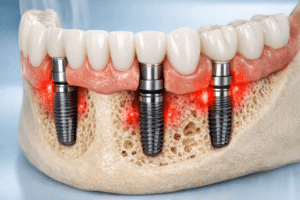Dental veneers are thin, custom-made shells or facings that cover the front part of your teeth for a natural appearance and a straight smile. Contoured from tooth-colored material, these veneers — including composite resin veneers — can correct chips, surface stains, gaps, crooked, or excessively worn teeth. Many patients choose resin veneers for an affordable and quick solution to achieve a flawless smile.
Table of Contents
ToggleEverything You Need to Know About resin veneers
Veneers can be produced from porcelain or resin composite veneers, each of which has its major benefits and drawbacks. Porcelain veneers resist stains better than resin veneers and are more closely matched to the properties of natural teeth. However, porcelain veneers blotch more easily than resin teeth veneers and can chip and fracture more readily than resin bonding veneers. Additionally, the preparation for porcelain veneers usually requires at least 0.5mm of enamel reduction, while resin veneers can often be produced with little or no preparation. Nevertheless, if a prepared tooth is ever lost or its position in the dental arch is altered, understanding dental implants vs veneers becomes essential to choose the best restoration option for your smile. , resin bonding veneers are advantageous since they can reestablish the smile with minimal or no orthodontics. Composite veneers can also be converted into temporary restorations and offer less invasive options for a quick smile improvement, but they may stain more easily and have a shorter lifespan than porcelain.
How Much Do Resin Veneers Cost?
When considering a smile makeover, knowing the cost of resin veneers is key. Many patients ask, How much do resin veneers cost? If you’re exploring options for a more affordable smile transformation, cosmetic veneers—including resin types—can offer a beautiful and budget-friendly solution. or How much are resin veneers? because they’re often more budget-friendly than porcelain. The cost of composite resin veneers can range from $250 to $1,500 per tooth, depending on the dentist’s skill, your location, and how many teeth you’re treating. The composite resin veneers price is generally lower for direct chairside veneers, while indirect ones may cost more due to lab fees. So, How much are composite resin veneers? really comes down to the materials, prep work, and your personal dental needs. Keep in mind that although resin veneers cost less upfront, they may need touch-ups or replacement sooner than porcelain. Still, for many, the cost of composite resin veneers makes them an affordable, quick way to get a bright new smile.
Types of resin veneers
There are two types of resin veneers – prefabricated and direct veneering. Prefabricated composite resin veneers (PRV) can be made from composite resin or polycarbonate, tailored case by case in various shapes and colors. They can generally be inserted using the same protocol as direct resin veneers. The only precaution is polymerization, as PRV templates are thicker and wider than the tooth. Both types of composite resin veneers can be polished and bonded directly in the mouth. The advantages of prefabricated veneers include simpler, faster, and more cost-effective processing, multiple application protocols, and better shade matching for cases like fluorosis. They also offer invisible margins and are more resistant to corrosion than other materials. Direct resin veneers bond to the enamel’s labial face and require detailed sculpting and polishing but offer great customization in shade and shape. Overall, composite resin veneers provide flexible solutions for smile improvements.
Resin Veneers vs Porcelain: What’s the Difference?
Both porcelain and resin veneer treatment options are well supported, and the study of their comparative advantages and clinical characteristics is ongoing. If you’re asking Are Veneers Permanent, it’s important to know how each type holds up over time. For a full breakdown of resin veneers, check out this guide on Are Veneers Permanent and see what to expect before choosing the right option for you. When considering resin veneers vs porcelain, non-ceramic materials offer easy manipulation and good aesthetic results, especially for direct bonding on anterior teeth. However, they’ve seen limited use in indirect restorations due to bond degradation and wear. Microfilled composite resin veneers show good wear resistance, but compared to porcelain veneers, they are rougher than enamel and prone to color changes over time. This highlights the key difference between porcelain and resin veneers when it comes to durability and long-term aesthetics. Clinical data shows that porcelain veneers vs resin veneers often deliver higher patient satisfaction. Composite resin veneers vs porcelain veneers also differ in plaque retention and color stability, while resin vs porcelain veneers studies continue to evaluate which option provides the best natural look and resilience for each patient’s needs.

A Permanent Reason To Smile: Top 5 Benefits of Resin Veneers
While cosmetic alternatives are plentiful, few excel when compared to composite resin veneers. What you may not realize is that resin veneers provide many advantages to improve your smile, uplift your confidence, aand reshape your teeth. They offer a natural look, minimal tooth reduction, and easy repairs if needed, all while keeping the dental veneers cost affordable for patients who want a beautiful smile without breaking the bank. — all at a more affordable resin veneers cost than porcelain. When comparing composite resin veneers vs porcelain veneers, resin options often feel more natural because they bond directly to the tooth without creating a bulky look. This is why many patients prefer porcelain veneers vs resin veneers discussions to understand the differences. Plus, if a chip occurs, composite resin veneers are simply repairable, saving time and money. Overall, the resin veneers cost makes them an attractive choice for a confident, long-lasting smile.
Why Do Patients Choose resin veneers ?
While cosmetic alternatives are plentiful, few excel when compared to composite resin veneers. What you may not realize is that resin veneers provide many advantages to improve your smile, uplift your confidence, and reshape your teeth. They offer a natural look, minimal tooth reduction, and easy repairs if needed — all at a more affordable resin veneers cost than porcelain. When comparing composite resin veneers vs porcelain veneers, resin options often feel more natural because they bond directly to the tooth without creating a bulky look. This is why many patients prefer porcelain veneers vs resin veneers discussions to understand the differences. Plus, if a chip occurs, composite resin veneers are simply repairable, saving time and money. Overall, the resin veneers cost makes them an attractive choice for a confident, long-lasting smile.
How long do resin veneers last?
While many patients prefer composite veneers to porcelain veneers, porcelain veneers, with proper care, can be a great option. Porcelain veneers typically last between 10-15 years, while composite resin dental veneers last around 4-8 years.
What are resin veneers?
Composite resin veneers are a porcelain alternative derived from translucent resin and meticulously sculpted and hardened by your dentist, typically in a single appointment. If you have worn, chipped, or damaged teeth, composite resin can be directly sculpted onto the teeth for exponential results.
What are the cons of resin veneers?
One of the biggest drawbacks of composite veneers is their durability. While they can give you an immediate improvement in your smile, they aren't as long-lasting as porcelain veneers. Composite material is more prone to chipping, cracking, and staining, especially when exposed to certain foods
Can you take off resin veneers?
Removal of composite resin veneers is generally safe. The removal process's success depends on many factors, including: Your natural tooth's condition before having the veneer placed. The expertise of your cosmetic dentist in performing the removal procedure
A AKBAROV, M TOLIPOVA – Журнал” Медицина и инновации”, 2022 – medin.uz. COMPARATIVE CHARACTERISTICS OF CERAMIC AND COMPOSITE VENEERS. medin.uz
Cited by 2
…, MM Sugii, KBFW Johanns, SAM van der Made – … of biomedical materials, 2021 – Elsevier. Comparison of conventional ceramic laminate veneers, partial laminate veneers and direct composite resin restorations in fracture strength after aging. sciencedirect.com
Cited by 80
SM Schmitz – 2023 – titula.universidadeuropea.es. Survival rate of porcelain veneers versus indirect composite resin veneers in patients with bruxism: a systematic review. universidadeuropea.es
T Mazzetti, K Collares, B Rodolfo… – Dental Materials, 2022 – Elsevier. 10-year practice-based evaluation of ceramic and direct composite veneers. researchgate.net
Cited by 53



